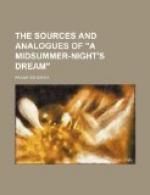[64] l. 235. Fyttes II and III are wholly concerned with the prophecies, and have nothing to do with the story of Thomas.
* * * *
Scot’s Discovery of Witchcraft.
[1] P. 135, l. 13. (Book IV, chap, x.) Hemton hamton. Cf. “himpen hampen” in Robin Good-fellow, and note, p. 189.
[2] P. 138, l. 20. (Book VII, chap, xv.) Kit with the canstick. Christopher-with-the-candlestick is another name for Jack-o’-lantern. calkers = diviners. For spoorn, see Wright, Dialect Dictionary, s.v.
[3] P. 140, l. 8. (Discourse, chap. xxi.) Hudgin is more usually spelled Hodeken, the German familiar fairy. Cf. the French Hugon, a bugbear used to frighten children.
* * * *
Strange Farlies.
P. 141. This extract from Churchyard was first cited by E.K. Chambers in his edition of M.N.D. in the Warwick Shakespeare.
[1] farlies, marvels.
[2] feared, frightened.
* * * *
The Mad Merry Pranks of Robin Good-fellow.
P. 144. This broadside is found in various editions in the larger collections (Roxburghe Coll., I. 230; Pepys, I. 80; also in the Bagford); the text here given is Percy’s collation (as printed in his Reliques) of one or two of the above. The tune of Dulcina was famous; it may be seen in Chappell’s Popular Music, 142.
* * * *
The Fairies’ Farewell.
[1] P. 153, l. 11. [need]. Poetica Stromata reads want.
* * * *
The Fairy Queen.
P. 155. The poem was given by Percy in his Reliques from The Mysteries of Love and Eloquence, a curious book of which the preface is signed E.P.; the British Museum Catalogue attributes these initials to Edward Phillips, the nephew of John Milton. But Rimbault pointed out that this song occurs in a tract of 1635, A Description of the King and Queen of the Fairies, attributed to Robert Herrick; a single copy of this pamphlet is known, and is in the Bodleian Library.
* * * *
Nymphidia.
P. 158. Michael Drayton’s fairy-poem was first published in 1627, and perhaps owes a little of its charm to Shakespeare’s play, though not so much as Drayton’s sonnets to those of the elder poet.
[1] P. 160. upright, flat on the back. This is the older meaning, which Drayton would find in Chaucer.
[2] hays, dances. Cf. heydeguys, p. 148.
[3] P. 161. aulfe. Cf. “ouphs,” Merry Wives of Windsor, V. v.
[4] Pigwiggen. “Piggy-widden” is a west-country dialect term, meaning a little white pig, used as an endearment for the youngest of a family.




